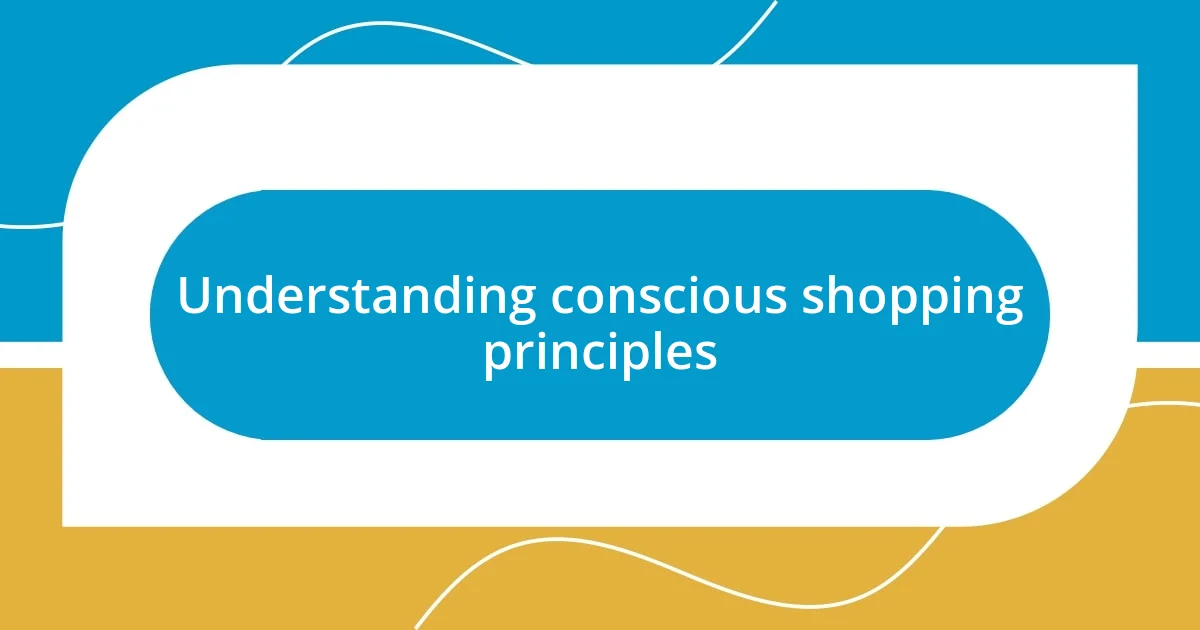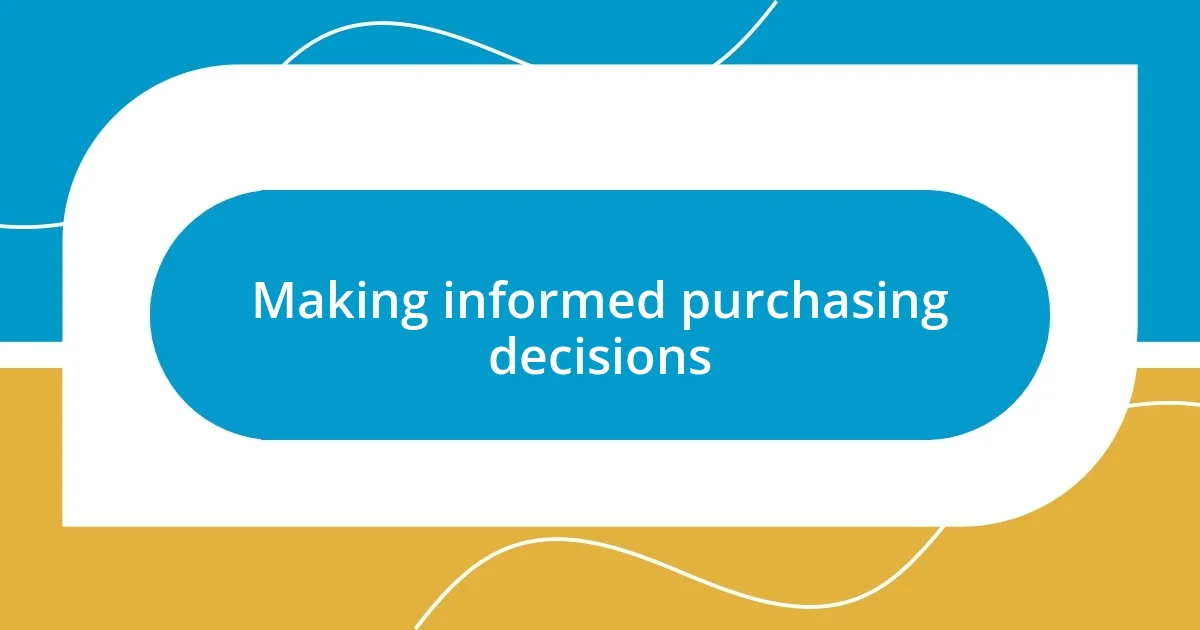Key takeaways:
- Conscious shopping emphasizes informed choices that prioritize sustainability, ethical production, and community impact.
- Identifying ethical brands involves investigating their transparency, certifications, sourcing practices, and commitment to fair labor and community support.
- Budgeting for conscious purchases and practicing minimalism fosters a more intentional shopping approach, prioritizing quality over quantity and aligning spending with personal values.

Understanding conscious shopping principles
Conscious shopping revolves around making informed choices that prioritize sustainability, ethical production, and overall impact on the planet. I still remember the first time I consciously decided to shop from a local artisan market. It felt empowering to support a community and see the direct impact of my choices on the environment and economy.
One principle I find vital is understanding the lifecycle of products. Have you ever thought about where your clothes end up after they’re discarded? I once learned that fast fashion contributes heavily to landfill waste, which opened my eyes to the importance of choosing quality over quantity. This mindset shift not only helped reduce my carbon footprint but also encouraged me to cherish items rather than treat them as disposable.
Lastly, the practice of evaluating the brands we support is an essential aspect of conscious shopping. For example, I made it a habit to research companies before purchasing their products, and it surprised me how many brands claim to be ethical while still engaging in questionable practices. By holding brands accountable, we actively participate in a movement toward more sustainable consumption. Isn’t it fascinating how our shopping habits can influence the marketplace?

Identifying ethical brands to support
When identifying ethical brands to support, I always dive into their transparency regarding sourcing and labor practices. I recall stumbling upon a beautiful clothing line that openly shared their fair trade certification and employee welfare initiatives. It felt like discovering a hidden gem, knowing that my purchase contributed to fair wages and safe working conditions. This transparency fosters a deeper connection with the brand, making me feel not just like a consumer, but a partner in their mission.
Here are some key aspects I consider when evaluating brands:
-
Certification: Look for recognized ethical certifications like Fair Trade, B Corp, or GOTS (Global Organic Textile Standard) that validate their claims.
-
Sourcing: Investigate where and how the materials are sourced. Brands using organic or recycled materials tend to show stronger commitment to sustainability.
-
Labor Practices: Check if the brand provides information about their labor practices, such as fair wages and safe working environments for workers.
-
Community Impact: Support brands that contribute to their local communities, whether through donations, partnerships, or community development initiatives.
I find that keeping these points in mind not only sharpens my shopping choices but also enriches my experience. It’s a little like embarking on a treasure hunt, where the real treasures are the values and stories behind each brand.

Evaluating product sustainability claims
Evaluating product sustainability claims can seem overwhelming, but I’ve found some straightforward approaches that make the process easier. One time, I picked up a bottle of shampoo that claimed to be “eco-friendly.” A quick glance at the ingredients revealed a long list of synthetics that really didn’t align with my values. This taught me to look beyond catchy marketing to verify the actual impact a product has.
It’s essential to understand the distinction between genuine sustainability and “greenwashing.” Greenwashing is when a brand exaggerates its eco-friendly efforts to appeal to conscious consumers. For instance, I learned that some companies label their products as “biodegradable” without providing details about the conditions required for decomposition. Always do the research! Look for complete transparency about the sourcing, production, and end-of-life options of a product.
When evaluating sustainability claims, I also turn to third-party certifications. They lend credibility to a brand’s environmental commitments. After I started focusing on products with certifications, my shopping list has transformed. That confidence leads me to feel more empowered in making better choices that resonate with my values. It’s a rewarding journey!
| Claim Type | What to Look For |
|---|---|
| Eco-Friendly | Check ingredient transparency and real environmental impact |
| Biodegradable | Confirm information about conditions for decomposition |
| Fair Trade | Ensure certification is from a recognized body with stringent standards |

Making informed purchasing decisions
When it comes to making informed purchasing decisions, I’ve learned that research is my best friend. Recently, I found myself in a local shop, staring at two similar products. One was a well-known brand, while the other was from a smaller company that emphasized its eco-friendly approach. I decided to dig a little deeper and discovered that the smaller brand sourced its materials sustainably and prioritized fair labor practices. This exploration didn’t just help me choose consciously; it felt like I was taking an active role in supporting something meaningful.
Another interesting lesson came from a recent online purchase. I was captivated by a stylish bag that claimed to be “sustainable,” but my curiosity nudged me to check the reviews. I was surprised to find that many customers raised concerns about the company’s sourcing practices. This experience taught me the value of community insights. Are there voices out there echoing my concerns? I’ve come to appreciate that customer reviews can reveal hidden truths about a product that marketing often overlooks.
Engaging with brands on social media has opened new doors for me in understanding their values. I remember asking a company directly about their plastic use in packaging, and to my delight, they responded promptly. This interaction made me feel seen as a consumer and reminded me that one question can lead to greater accountability in the marketplace. Being proactive in seeking information not only empowers my buying decisions but also encourages brands to maintain the integrity of their commitments. Isn’t it exciting to think that our inquiries can shape the marketplace for the better?

Practicing minimalism in shopping
Practicing minimalism in shopping has completely transformed how I view my purchases. Instead of filling my cart with items that spark a fleeting joy, I’ve learned to embrace the idea of quality over quantity. Recently, I sat down and reflected on my wardrobe, realizing I had too many clothes that I rarely wore. This epiphany led me to curate my closet, keeping only those pieces that truly resonate with my personal style and that I feel comfortable wearing. Doesn’t it feel refreshing to let go of items that no longer serve a purpose in our lives?
I’ve also found that embracing minimalism helps to reduce the overwhelming pressure to keep up with consumer trends. I remember feeling anxious when friends would flaunt their latest gadgets or fashion finds. Now, I focus on evaluating my needs instead of succumbing to societal pressures. For instance, when my phone started acting up, I resisted the urge to buy the latest model and reassessed whether a simple repair could suffice. This shift in thinking not only saves me money, but it also cultivates a sense of intentionality in my choices. Have you experienced that added pressure of wanting what everyone else has?
Moreover, minimalism encourages me to invest in more sustainable and timeless pieces. I’ve shifted my focus to brands that prioritize ethical production and durability. When I recently saved up for a well-crafted backpack, it wasn’t just about the product itself, but the story behind it. Knowing that my purchase supported skilled artisans made the investment worthwhile. Isn’t it charming to think that my conscious choices can have a ripple effect, benefiting communities and the planet? Each time I shop mindfully, I feel more connected to my purchases, and the experience becomes less about material accumulation and more about meaningful engagement.

Budgeting for conscious purchases
Budgeting for conscious purchases requires a shift in how we allocate our financial resources. I once found myself torn between a trendy pair of shoes and a higher-quality option made from sustainable materials. It was a small moment of reflection, asking myself if I’d wear the trendy shoes a few times or if I would cherish the sustainable pair for years. I chose the latter, realizing that investing in quality not only meant less frequent shopping trips but also aligned with my values.
Creating a conscious shopping budget has been enlightening for me. I started by tracking my expenses and identifying areas where I could cut back, such as dining out or impulse buys. This process allowed me to reallocate those funds towards brands that resonate with my ethical standards. Have you ever considered how much a few less take-out meals could contribute to a meaningful purchase? It’s empowering to see how small adjustments can lead to more impactful spending.
Lastly, I’ve learned the value of setting a specific fund for conscious purchases. I call it my “impact account.” Every month, I set aside a designated amount, and when the time comes to shop, I feel both excitement and purpose. It’s not just about splurging; it’s about making choices that echo my beliefs. Each purchase from this fund feels like a vote for the kind of world I want to support. How exhilarating is it to know that your budget can reflect your values? These experiences remind me that spending consciously isn’t a sacrifice; it’s a meaningful investment in my ideals.












